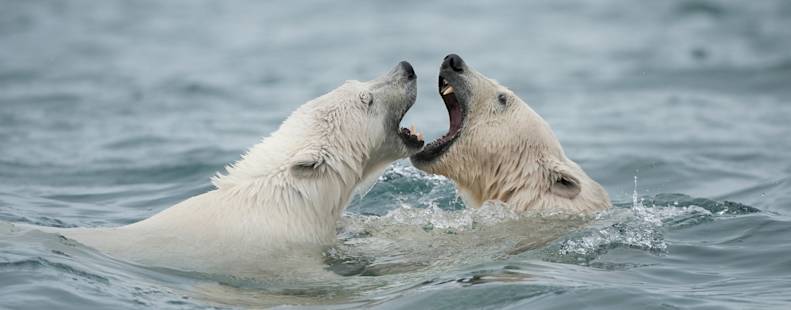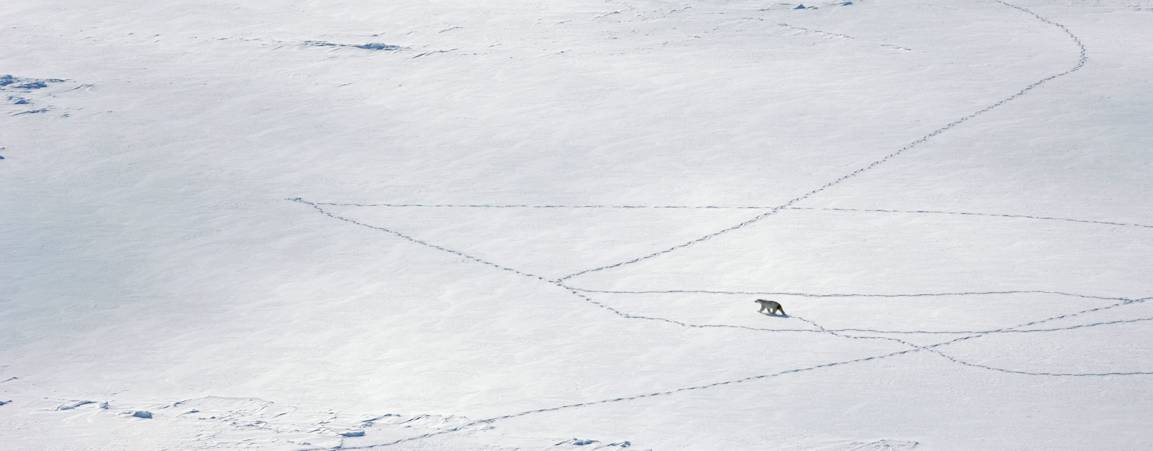Genetics Studies

Photo: Daniel J. Cox
By taking a deep dive into polar bear genetics, we can answer key questions about the bears, gathering survival clues and other critical information.
How diverse are polar bears? Do genes play a role in their survival? Are problem bears predisposed to higher risk behavior or is that behavior learned?
Thanks to scientific advances, we can now analyze the polar bears’ DNA and answer these, and other, questions.
Decoding Polar Bears
Genetics can tell us a lot about polar bears, including when they split off from brown bears and how changes in their genes led to the bears that we know today: with white fur, small ears, and adaptations that help them not only survive, but thrive, in an Arctic marine environment.
DNA samples from individual bears tracked over time can also shed light on how genetic differences impact their survival and reproduction. In addition, genetic profiles can help us understand how diverse polar bears are, an important factor in their conservation. Individual genetic ID is also a key tool in conducting less invasive population monitoring and abundance estimation.


“Assessing and conserving the genetic variation that exists amongst the world’s polar bear populations is an important first step for the long-term conservation of the species.”
— Dr. Evan Richardson, Environment and Climate Change Canada
Current Projects
Polar Bear Genetics in a Warming World
Using current technology, this project involves building a detailed polar bear pedigree to find out more about how genes flow and how genetic diversity may contribute to the species’ long-term survival. Specifically, researchers are examining Canada’s smallest polar bear population, Norwegian Bay, to better understand the bears’ diversity and how this may impact survival rates. Additionally, they are analyzing long-term data on known problem bears in Hudson Bay to see if undesirable behaviors like approaching human settlements, are learned from their mothers or inherited (or both).
This work is the first of its kind for polar bears and will offer incredible insights into what the future indeed looks like for this species in different areas of the Arctic.
Project partners include Dr. Ian Stirling, University of Alberta; University of Toronto; Environment and Climate Change Canada; and San Diego Zoo Wildlife Alliance. Project funders include Columbus Zoo and Aquarium.
Barents Sea Polar Bear Study
The Barents Sea polar bear population, located in Svalbard, in the Norwegian Arctic, has experienced the fastest loss of sea ice habitat in the past decades, a trend predicted to continue. Earlier genetic work on Barents Sea polar bears by the Norwegian Polar Institute provided key insights into their population dynamics and genetics. Still, much more knowledge is needed to fully understand what is happening.
The Barents Sea polar bears are undoubtedly facing incredible change in the coming years. Significant changes in mating systems, including increased isolation and decreased gene exchange between local and migratory bears, are anticipated to occur due to rapid sea ice changes in this region. Also, more restricted interaction between bears from various areas may lead to increased inbreeding.
By examining long-term genetic data, researchers will better understand how such changes impact polar bear health, reproduction, and movements. This knowledge will help build our understanding of the polar bear’s adaptive potential, and the role of genetic diversity in population viability, a critical component in the species’ long-term conservation.
Project partners include the Norwegian Polar Institute, Russian Arctic National Park, and Quark Expeditions. Project funders include Columbus Zoo and Aquarium and the Wildlands Adventure Zoo Emmens.
Wrangel Island Polar Bears
The genetic structure of polar bears is incompletely understood. Many of the 19 populations, particularly those partially or fully in Russian territory, are data-deficient, leaving gaps in our understanding of global polar bear diversity and presenting management challenges
In Russia, the Wrangel Island State Nature Reserve is used by the Chukchi Sea population of polar bears as a denning area for females and cubs and a terrestrial refuge for all bears during the ice-free season. In 2016, Russia and the U.S. initiated a collaborative study to understand the island’s importance to the Chukchi Sea population.
Through non-invasive hair traps that collect genetic samples, researchers are sequencing the polar bear genome of these bears. The project will help describe patterns of gene flow, diversity, and population dynamics for polar bears across the Eastern Arctic Basin.
The study has already affirmed Wrangel Island’s critical importance to the Chukchi Sea bears, especially in the context of longer ice-free seasons due to climate warming. Such data will inform a subsequent study of the polar bears’ geographic origin on this critical resting place for polar bears.
This project is led by the University of Washington and the Wrangel Island Nature Reserve, and supported by partners including Polar Bears International, the U.S. Fish and Wildlife Service, the All-Russian Research Institute for Environment Protection, and the University of California Santa Cruz. Polar Bears International’s funding support includes gifts from Salesforce and the High Point Community Foundation - The Molly Millis Fund.
View More Projects
Photo: BJ Kirschhoffer













